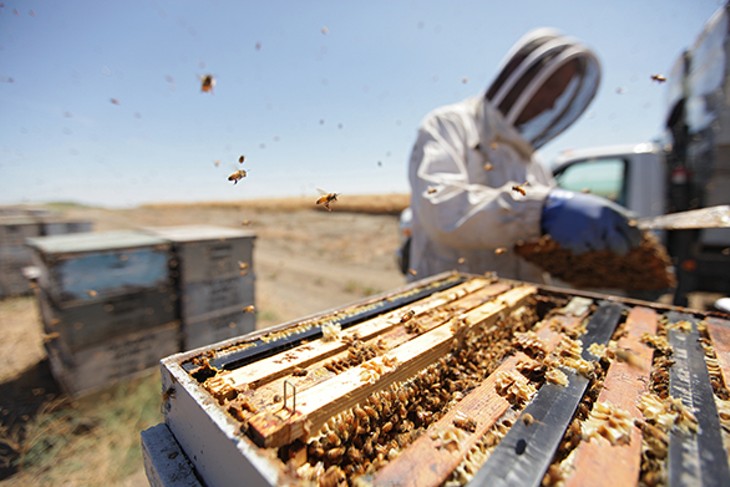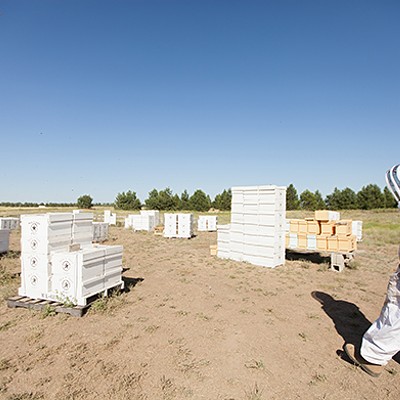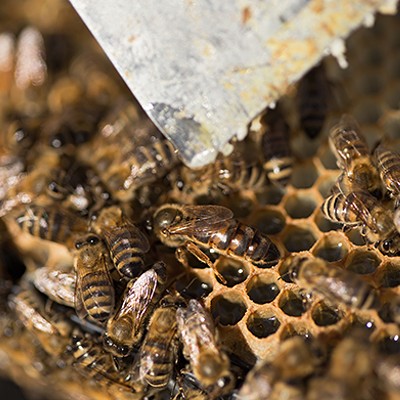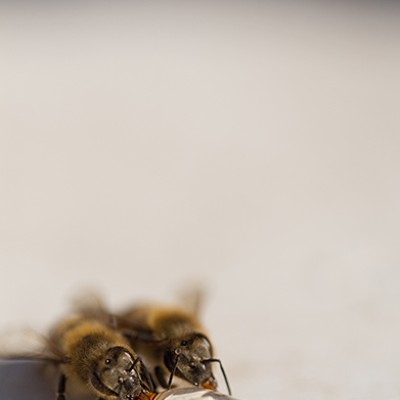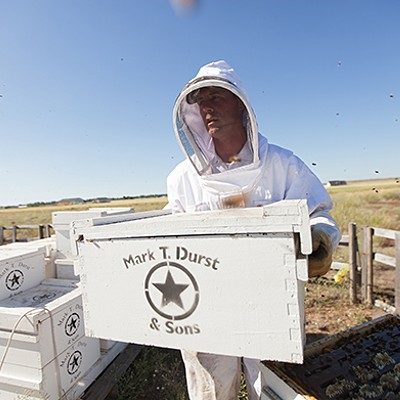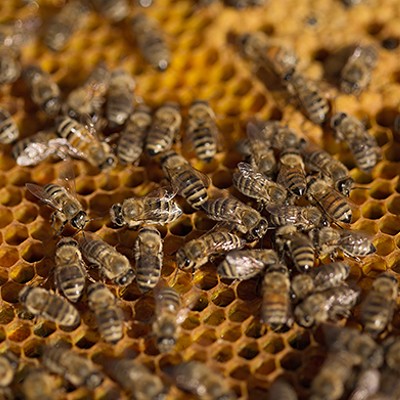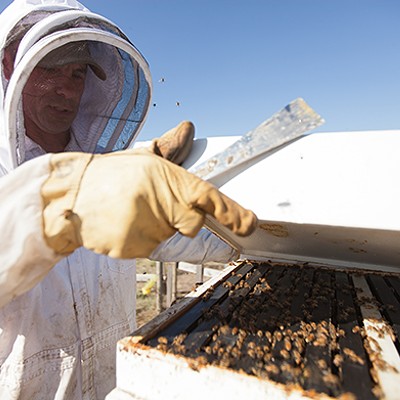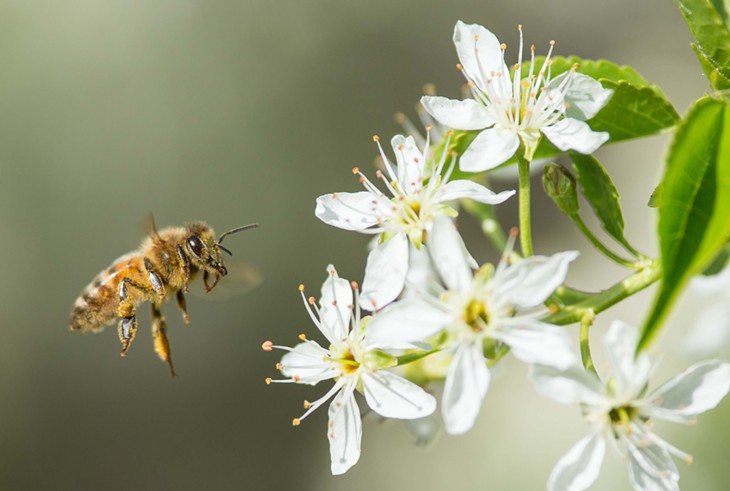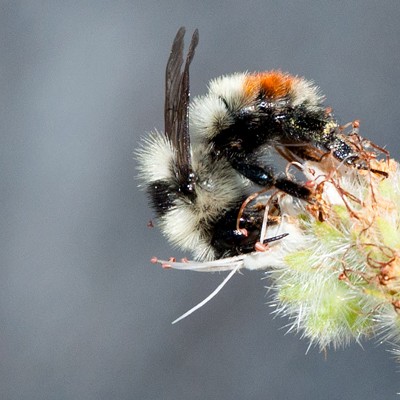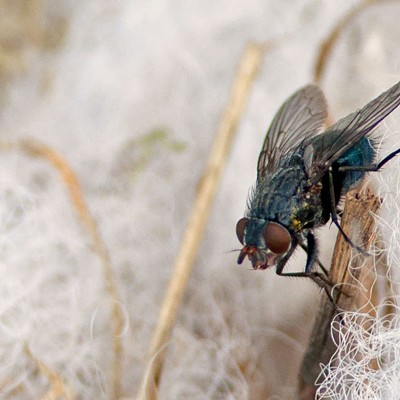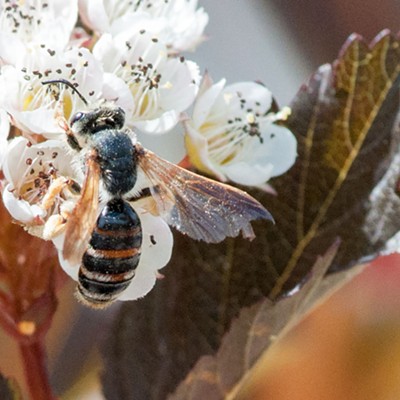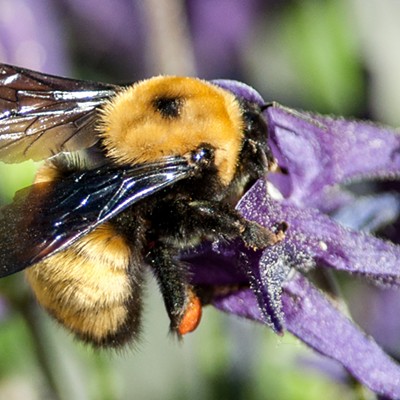Eric Olson is giddy as he wanders the California cow pasture where he winters his honey bees. The spring season should pay off spectacularly.
It’s early February of 2011. He’s in Waterford, about 20 minutes east of Modesto, for the state’s annual almond bloom, the largest pollination event in the world. Olson is 68, white-haired and sturdy, and with more than 13,000 colonies, he’s by far the largest commercial beekeeper in Washington state. Renting out his hives at $150 a pop, he stands to walk away with a cool million.
But as he and his crew begin peering into hive boxes, Olson feels a lump in his throat.
There should be tens of thousands of worker bees — gathering pollen, secreting wax, building perfect hexagonal cells — but here, between wood and wire frames still oozing honey, only the queen and her brood hang on amber-colored comb.
One box after the other: Empty. Hundreds of them. Olson lifts lids at random. Empty again. And the next. And the next, save for a few dozen bees clustered in a measly fist-sized clump. Those hives are basically good as dead.
It takes Olson and his crew six weeks, working 10-hour shifts, to separate the dead hives from the live ones: Of the 13,578 hives he trucked to California, 9,000 — nearly two-thirds — are gone, costing him $1.4 million.
At the end of the day, after Olson gets back to his room at the Holiday Inn Express, he falls apart.
“There’s no worse feeling in the world than seeing all your bees dead,” he says. “You get attached to these little buggers, and you just feel like you’ve let them down, and you have.”
Colony collapse disorder, an enigmatic phenomenon, is now a catch-all term for unprecedented and large-scale honey bee disappearances. Twenty years ago, it wasn’t uncommon for beekeepers to lose 10 to 20 percent of their hives, but by the spring of 2007, migratory beekeepers in several states began reporting crippling and inexplicable losses, varying between 30 and 90 percent of their stock. There’s no single explanation for this rapid decline, or miracle cure to reverse it. Since 2006, roughly one in three honey bee colonies in the United States, on average, haven’t survived the winter.
If honey bees are the proverbial canaries in the coal mines, as many scientists believe, their decline may portend more pollinator die-offs, imperiling our ecosystems and threatening global food security. Some 75 percent of all crops rely on animals and insects for pollination. Without them, we’d be stuck with a diet of wheat, corn and rice.
Dwindling honey bee populations may mean smaller harvests, rising food prices and fewer apiarists willing to stake their livelihoods on a species with such a precarious future. It’s been seven years, and beekeepers, farmers, entomologists, regulators and environmentalists are still scrambling for answers as all of their fates, and much of ours, are tangled with the vitality of the honey bee.
“No Smoking Gun”
Stories of bees vanishing from seemingly healthy hives emerged long before the alarm was sounded about colony collapse in late 2006. Researchers have identified at least 18 isolated episodes of unusually high colony losses as far back as the late 19th century.
In an old trade journal for beekeepers called Gleanings in Bee Culture, a concerned reader wrote in to describe May Disease, “a new malady” in which bees across Colorado “completely evaporated” over the course of a few days in May of 1891 and 1896.
“[M]any said it was high winds. Others said it was the smelter smoke that killed them,” he wrote. “It remains yet a complete mystery.”
The honey bee population in the United States has in fact been declining for the past few decades, even as the agriculture industry’s reliance on pollinators has grown. Since 1947, the number of managed colonies in the U.S. has dropped from a high of 5.9 million to roughly 2.5 million today. Every year, beekeepers like Olson truck 1.6 million hives — two-thirds of all commercial colonies — across the country to pollinate 760,000 acres of California almond groves. After last winter’s bee die-off, almond growers risked not having enough bees to guarantee their yields.
A federal report published this past May concludes that the current survival rate of bee colonies is so low that regulators aren’t confident in their ability to meet pollination demands. As the USDA’s top bee researcher Jeffery Pettis says: “We are one poor weather event or high winter bee loss away from a pollination disaster.”
Dennis vanEngelsdorp, an entomologist from University of Maryland who surveys U.S. colony declines, agrees.
“We’re right at the brink of having shortages of movable colonies in the U.S,” he says. “One in every three bites we eat is directly or indirectly pollinated by honey bees. … If we do have that [shortage], we won’t be able to produce apples, almonds and a whole variety of crops in this country.”
As colony collapse deaths climbed, the urgency to pinpoint the cause grew desperate. People blamed pesticides, fungicides, viruses, cellphone radiation, genetically modified crops, global warming and even, as the New York Times reported in 2007, “a secret plot by Russia or Osama bin Laden to bring down American agriculture.”
“Everyone was hoping for this one single answer,” says Washington State University entomologist Steven Sheppard. “But by about 2009, 2010, people realized there doesn’t seem to be a single answer. … There’s no smoking gun.”
Most scientists now agree that a combination of long-existing factors — pesticides, fungicides, pathogens, malnutrition, parasites and monocultures — are weakening our domesticated honey bees. The University of Maryland’s vanEngelsdorp says colony collapse disorder isn’t the problem it once was. “What we see are a lot of dying colonies or dwindling, rather than collapsing,” he explains.
“One way to perhaps think about it is that it’s just been an attrition of quality of life for the bees,” says Sheppard. “The overarching and more important concept is the need to be concerned with colony health.”
Recent declines in bee populations are a reflection of our constantly changing agricultural industry. Not only is trucking hives across the country stressful for bees, but congregating them in massive holding yards is a quick way to spread disease. Farmers are also treating their plants with a merry-go-round of pesticides and fungicides, and honey bees are now suffering from long-term exposure.
Indeed, as the parasitic Varroa mite — the single most destructive honey bee pest worldwide — builds up resistance to pesticides, new chemical treatments are developed that may have even worse effects on bees.
“The number of beekeepers who have gone out of business is a very long list,” says Sheppard. “Living in a chemical treadmill and doing everything the way you’ve done it before is just not working.”
Public Enemy No. 1
Fifty thousand bumblebees dropped dead in a Target parking lot in Oregon this past June.
The scene at the shopping center looked something like a war zone. “Yellow-faced bees fell from the trees, twitching on their backs or wandering in tight circles on the asphalt,” described the Oregonian newspaper. “A few dead bumblebees even clung to linden flowers, while hundreds littered the lot.”
A few days earlier, a landscaper had doused 55 linden trees in the parking lot with an insecticide called Safari. In response, the Oregon Department of Agriculture instituted temporary restrictions on more than a dozen different insecticides containing dinotefuran, Safari’s active ingredient. Environmentalists felt vindicated: The culprit behind the massacre was part of a class of nicotine-derived pesticides known as “neonicotinoids” — the most high-profile suspect in colony die-offs.
Introduced by the German chemical behemoth Bayer in the mid-1990s, neonicotinoids are the fastest growing class of insecticides in the world. You can find them in your local hardware store or garden center under names like Bayer 2-1 Systemic Rose and Flower Care.
“Neonics,” as they’re often called, are systemic insecticides: Once applied, the plant absorbs the insecticide chemicals, which circulate throughout its tissue. Neonics work by attacking the central nervous system of any insect that feeds on it. Evidence suggests neonics disorient bees, impair their memory and reduce their capacity to forage for food. Some scientists, environmental advocates and beekeepers believe that low-level exposure from contaminated pollen and dust are weakening and slowly killing our bees.
“It dumbs them down. They don’t seem to learn as well. They don’t seem to interact as well and function as well,” says Mark Emrich, an Olympia-based beekeeper and president of the Washington State Beekeepers Association, who unsuccessfully organized a petition asking the state Department of Agriculture to restrict the use of the pesticides in urban Thurston County. “Our educated guess is the fact that these neonics hit the scene at the same time we started gathering all these losses.”
There’s no question that neonics, when administered to bees in laboratory settings, are extremely toxic, but field data is scant. After all, most honey bee colonies as a whole forage on multiple sources of nectar and pollen, and according to WSU’s Sheppard, it’s unclear if neonics alone have any detectable harmful effects on honey bees in the real world.
But the lack of evidence hasn’t stopped public backlash. This past April, the European Union, which is also contending with colony declines, voted for a two-year ban on neonicotinoids. Three months later, Reps. John Conyers, D-Mich., and Earl Blumenauer, D-Ore., followed Europe’s lead and introduced the “Saving America’s Pollinators Act of 2013” to suspend the use of neonics until the EPA conducts a full review. Seeking to eliminate the use of these insecticides, beekeepers from Minnesota, along with a handful of environmental advocacy nonprofits, are suing the EPA.
There’s “a beauty and a danger to these systemic insecticides,” Sheppard explains. Since neonicotinoids persist in plants for months, they reduce the frequency of exposure for humans spraying the chemicals and organisms running into them. “The downside is: Where is that level of exposure to bees that actually harms the colony? That’s a little bit muddled.”
And if we ban this class of pesticides, Sheppard wonders, “What’s going to take their place?”
If the outsized public interest regarding neonics has accomplished one thing, it’s a flurry of research on the pesticides’ effects. This fall, Sheppard will lead his own study, sampling pesticide levels in hives from urban and rural areas in the Olympia region. His findings may prove what Emrich and other Thurston County beekeepers have been saying all along — that neonics are indeed a problem for city beekeepers — or that they’re another red herring in a hunt for answers.
Still, there are other threats to bees, and so Sheppard, who specializes in genetics and was part of an international research team that sequenced the honey bee genome, wants to build a stronger bee. He and his WSU research partner, Susan Cobey, are creating a honey bee sperm bank — gathering semen samples from honey bee subspecies in Italy, the eastern Alps and Georgian mountains — so that beekeepers eventually might cross-breed more robust and resilient bees.
“We’re trying to breed bees that can deal with these pathogens a bit on their own,” says Sheppard. “Eventually, I think what we’re going to need to do as beekeepers is to develop bees that are more resistant or tolerant to mites, and then use less chemical treatments in the hives.”
“Let Them Be”
Mike Durst doesn’t listen to “any of that trash”— the latest study, the hottest theory, the finger-pointing and name-calling from beekeepers, agrichemical companies, greenies and scientists.
“I know chemicals have to affect them,” he says. “You don’t have to be a scientist to figure that out. … So I try to let common sense be the guiding rule there, and then you know, let them be.”
Durst (which everyone calls him) operates his own commercial apiary, Mark T. Durst and Sons, with his wife, father-in-law and a handful of friends, near the Fairchild Air Force Base in Medical Lake, Wash. He has broad shoulders, sinewy arms and yellow pollen in the grooves of his fingers. He turns 43 this month, so he’s young by beekeeper standards. He squints beneath the shadow of his olive drab cap and talks high-speed from the side of his mouth in an even Appalachian drawl.
He’s also wearing a full bee suit, which he normally doesn’t, except when he’s moving hives. That’s another rule. Last spring a pallet of hives on the back of his tractor snapped, sending a colony of agitated, cold and tired honey bees tumbling over his bare face and hands. They stung the snot out of him.
“That’ll bring you a little closer to Jesus, having 60,000 bees on you,” he says.
Durst doesn’t feed his bees corn syrup, just sugar water when their food stores are low. He pollinates as locally as possible and in organic orchards. He doesn’t treat his bees with any chemicals. Instead he makes grease patties out of sugar and essential oils to ward off any mites.
And he hasn’t had any mite problems. Since he began beekeeping in 2006, he hasn’t had any colony collapse problems either. His winter losses average between 10 and 20 percent.
“You can’t do what I’ve done and see what I’ve seen and not care about acting in a positive way,” he says. “I don’t wanna jinx myself, but my hands-off theory seems to be working.”
A Navy vet and third generation beekeeper, Durst learned how to extract honey, rear queens and graft eggs from his grandfather in the West Virginia panhandle when he was 8 years old. After he retired from the the military, he worked a string of odd jobs that he couldn’t stick with. So he started beekeeping and says it’s like “therapy for me.” Durst won’t say exactly how many hives he owns — “because it’s a dog-eat-dog world out there” — but here in Medical Lake, he’s got 180 hives pollinating wildflowers and weeds on 31 acres for the upcoming honey harvest.
In the holding yard, Durst tenderly pries honey-slicked frames apart with a dull 10-inch-long blade that looks like a painter’s palette knife. He’s careful about stacking the boxes, one on top of the other, so he’s doesn’t crush any bees hovering in between.
“Between the explosions and getting hit in the melon so many times, sometimes I can’t even speak straight,” he says. “So you knows it’s just nice to be able to come back and see reality, and see how they work together and say, ‘Hey man, you know, if these insects can get it together, so can I.’”
Some days he’ll sit on an overturned bucket and watch his bees buzz madly above purple clover, vetch and phlox.
In the orchard, bees queue up for a drink on shaved pieces of oak floating in a small pool of water. He crouches over them.
“Look up at the horizon of the flowers,” he says, pointing. “Look at the world we’re in.”
As one bee slips into a pool, Durst gently scoops it out with his finger and back onto a floating board.
The Beekeeper Effect
After 33 years in the business, Eric Olson didn’t know whether he’d hang on to his house or his orchard.
In 1977, Olson’s parents sold him their Yakima ranch after he got home from an Air Force tour in Guam. He bought his first package of honey bees in 1979 (seven out of 10 of his colonies died), and in 1980, he rented his first set of hives. But by the spring of 2011, having lost more than 60 percent of his bees, Olson figured he was bankrupt. He had a choice to make: “Do you keep on going or give up and quit?”
Olson didn’t want to go out like that.
So he took a loan from the bank, got some help from the USDA’s Emergency Livestock Assistance program, and invested the rest of his savings into buying more bees. He got an idea: A friend and mentor of his had long been wintering his hives in potato cellars in Idaho, and he’d never experienced the big die-offs plaguing the industry.
The following year, Olson didn’t truck his bees to California in November for the annual almond bloom in February. Instead, he leased three controlled-atmosphere storage rooms from the Upper Valley Fruit warehouse a few miles down the road. He kept the temperature at 40 degrees, lowered oxygen levels and increased carbon dioxide, forcing his bees into a deep sleep. For 60 days, before daylight and after dark, he checked on his girls, monitoring the gases and temperatures in the engine room outside.
Coming out of storage in January 2012, he knew his bees would be good, but not this good: His losses totaled 4.4 percent. He did even better last year, losing an unheard-of 3.3 percent of his hives.
“It was thrilling. We’re excited. We’re tickled pink,” says Olson. “Like I said, I did not want to go out that way. I did not want to go out that way.”
WSU’s Sheppard thinks the higher levels of CO2 may have decreased the bees’ metabolic rate, causing them to eat less and age more slowly. Now Olson is working with WSU to study the effects of controlling the temperature and atmospheric gases on indoor wintering bees.
In two years, Olson more than recouped his losses. This summer, he had an all-time high of 18,713 hives spread between Mott, N.D., and western Washington, down in Ritzville and Umatilla, Ore., and up to Odessa and Coulee City.
Olson is at the top of his game. But he’s 70 now. On Jan. 1, 2016, Olson will hand over operations to 37-year-old Matthew Shakespear, a commercial airline pilot who got hooked on beekeeping.
Shakespear (the Bard’s uncle is his 17-generations-back grandfather) has been a beekeeper with Olson’s Honey for six months. Before that, he ran his own small-scale operation. He’s tall and soft-spoken with milky blue eyes and short gray hair. It’s 98 degrees in Olson’s Moses Lake holding yard, where his bees are pollinating some 130 acres of sunflowers.
Shakespear smiles gently, often and reflexively, as he works his bees, calming them first with a smoker before he pulls out sticky frames and removes polymer Apivar strips, a chemical treatment for killing mites.
“There are several places out there, where you read, ‘Bees have been around for thousands of years. They can manage on their own. They’ll take care of themselves,’ which is true,” he says, “But in nature, when they’re left to themselves, only about 20 percent of every swarm that leaves the hive survives through the next year. … Really, beekeepers can have a big effect on the survivability of the hive.”
For Shakespear, the future of beekeeping isn’t all “doom and gloom.” In fact, he sees opportunity to experiment, to get on the cutting edge. Olson, for one, does his bookkeeping in a spiral-bound notebook. But Shakespear hopes to buy a computer and software program that could help track his hives as they move across the country, ensure that they’ve been checked in on and fed. If beekeepers are going to survive, they have to innovate.
Back in the holding yard, Shakespear pulls out a frame covered in dark leathery wax. Something smells faintly of spoiled milk and rotten eggs. He calls this a classic case of “beekeeper neglect.”
“This yard fell through the cracks,” he says. It’s one of the downsides of managing so many hives.
There’s no queen in sight and a disproportionate number of male drones.
“What’d you do to me, Fermin?!” he shouts, with facetious exasperation, to the other beekeeper in the field.
Shakespear pulls out another frame. And another. Only a few dozen workers cling to the dry, rust-colored comb. He sighs and moves on to the next hive.


